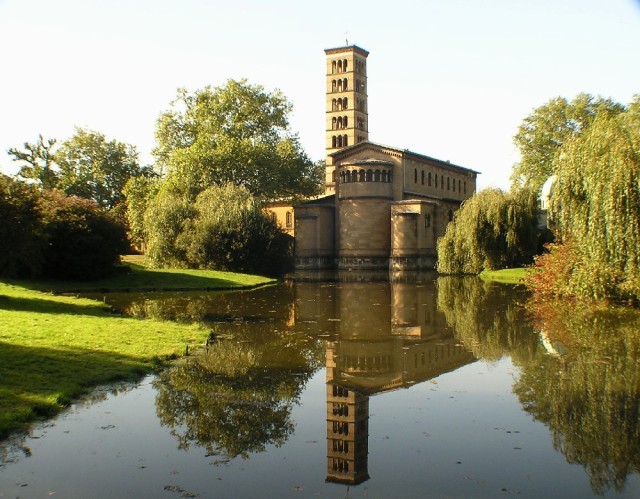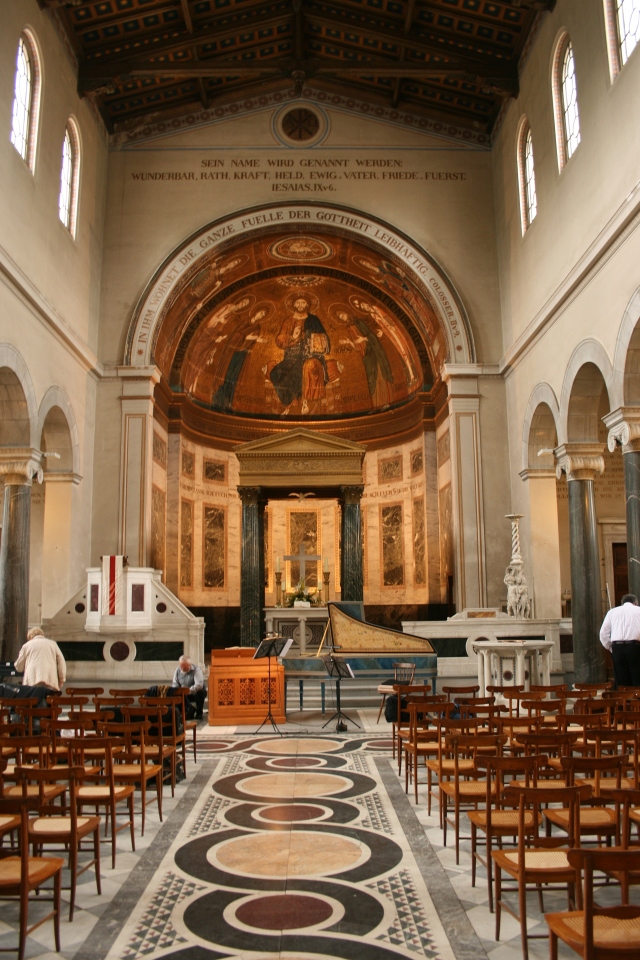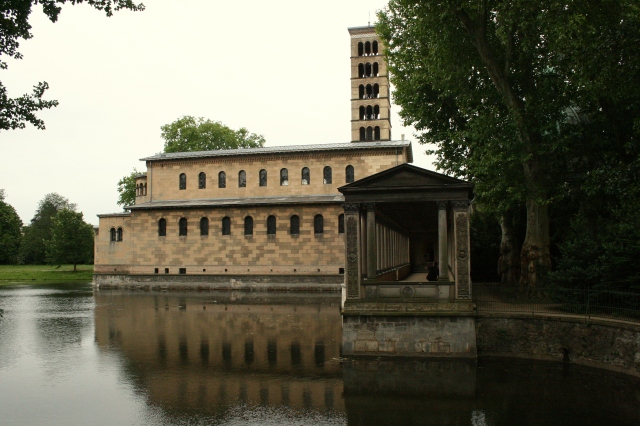Friedrich Wilhelm IV and the Prussian Dream of Byzantium
av Tonje Haugland Sørensen
Situated near a lake in the lush park of Sanssouci in Potsdam, the Friedenskirche appears like some perfect, picturesque piece of medieval wish-fullfilment. In a sense it is.
The church, a three aisled basilica without transept and with a freestanding campanile, was constructed from 1845 to 1848. It was ordered by the Prussian king, Friedrich Wilhelm IV, largely based on the king’s passion for all things early medieval and coupled with what the king saw as the need to rebuild Prussia after the Napoleonic war, not just physically, but spiritually. Because, for a spiritual reconstruction, surely few things were more appropriate than a church?
The architect behind the design was Court Architect Ludwig Persius, but when he died in 1845, the task of construction was handed over to Friedrich August Stüler, with the assistance of Ferdinand von Armin and Ludwig Ferdinand Hesse. The template was the church of San Clemente in Rome, but supplemented with the campanile of Santa Maria in Cosmedin, also in Rome. While still a Crown Prince, Friedrich Wilhelm had visited Rome during his trips to Italy in 1828 and 1835, but the San Clemente he then visited was the Upper Basilika with its Baroque refurbishing. While the travels to Italy can be said to have been of importance for the future king’s choice of San Clemente as a template, of equal importance was the idealized illustration by Johann Michael Knapp in Denkmale der christlichen religion, by architect J.G. Gutensohn and with illustrations by Knapp. Originally published in 1822-28, this work was republished in 1842, with an introduction by Carl Josias von Bunsen, diplomat and theologian as well as a close friend to King Friedrich Wilhelm. Bunsen’s own work, Die basiliken des christlichen Roms (1842-44) followed many of the same lines in idealizing early Christian architecture, but Bunsen also argued that the Roman basilicas were particularly suited for the Protestant way of worship. The past, as Bunsen saw it, should be adapted to serve the need of the present. Friedrich Wilhelm it appeared, agreed with him.
Friedenskirche was not the Prussian King’s only foray into an idealized, historcized concept of the early Middle Ages. In the years directly preceeding the building of Friedenskirche, he ensured that Ludwig Persius with the assistance of Ferdinand von Armin, had been responsible for the design and construction of the Heilandskirche, also in the Potsdam area. Finished in 1844 the Heilandskirche could be argued to be a direct persecutor of the Friedenskirche, in that it has a very similar design, being also a three aisled basilica with a freestanding campanile and a clear Medieval inspiration.
Taken together the Heilandskirche and the Friedenskirche can be seen as symbols for the Kings desire to return to what he saw as the purer, truer ideals of Constantine the Great and the Christianity of early Byzantium. Which is not to say that the staunchly Protestant Friedrich Wilhelm IV wished to distance himself from the legacy of Luther, but rather that the age of Constantine had acquired for him the status of an ideal.
Operating with sense of Otherness and exoticism towards Byzantium is nothing novel in Western Europe. When Montesquieu argued in his Considerations on the Causes of the Greatness of the Romans and their decline (1734) that in Byzantium (as he named it) “a universal bigotry numbed the spirit and enervated the whole empire” and “made all virtue consist in an ignorant and stupid passion for icons”, the stage was set. While the 19th Century saw an increasing turn away from the description of Byzantium as a nefarious, decadent entity, the tradition of perceiving Byzantium as the Other persisted. This form of byzantinism constructed a Byzantium that was all that Western Europe was not – resulting in a Byzantium that was spiritual, decadent, exotic, effeminate and mystical. The positive or negative interpretations of these attributes was however dependent on the specific historical and cultural context. For Montesquieu Byzantium was clearly a bad idea, while for a growing number of Germans in the middle of the 19th Century the spiritual and exotic version of Byzantium fitted well with the ideas and philosophies of Romanticism, as well as with the increasing interest in the Middle Ages.
For Friedrich Wilhelm IV it was the idea of the spiritual Byzantium that enchanted, coupled with the ideal of a divine monarch that the Prussian king saw embodied in Constantine the Great. The past was a place for inspiration, and in a sense an ideal to return to, a much as it was an object of scholarly study. As such it is tempting to analyze byzantinism with the concept of Cultural Memory, as coined by Jan and Aleida Assmann:
“The concept of cultural memory comprises that body of reusable texts, images, and rituals specific to each society in each epoch, whose ‘cultivation’ serves to stabilize and convey that society’s self-image[…]The content of such knowledge varies from culture to culture as well as from epoch to epoch.” (Assmann 1995)
Cultural memory is concerned with how the past is given meaning in the present, to ensure that history is felt to be meaningful for collective, and to establish a sense of continuity with the past while also ensuring a sense of singularity in time and space, a creation of a shared past via an historical consciousness.
This is perhaps illustrated by the inclusion in the Friedenskirche of a medieval mosaic, originally from San Cipriano in Murano, near Venice. It depicts a deesis, with a rather stern Christ at the centre. Flanking Mary and John the Baptist are, respectively, St. Peter and St. Cyprianus, and on the bema one finds Raphael and Michael, as well as an Agnus Dei in an Oktogram. While still a Crown Prince, Friedrich Wilhelm bought this mosaic and at great expense he had it shipped to Berlin. Its inclusion in the church is mentioned in Persius’s earliest notes about the construction, and in the finished church it graces the apse, a sparkling gold amidst an otherwise white and austere church interior. The effect is a contrast between the dazzling detail of the mosaic, and the stern simplicity of the rest of the interior. A contrast that highlights the mosaic both as centrepiece in the interior decoration, yet also establishes its status as historical object. A relic from a bygone area, that both decorates the church as well as commemorates the Medieval church it is meant to represent.
The mosaic is not there simply to inform us that this is a religious building, but also to make us aware the historical perspective the church wishes to situate itself in. Friedenskirche can thereby be said to function as what Assmann terms a memory aid, a cultural artifact that helps the production and preservation of cultural memory. The Friedenskirche is a church, a house of worship suited for a congregation, but it is also a place of commemoration and of remembrance of things past; in this case not just the gospels, but Christianity’s earliest history as a state religion. Or at least how the latter was interpreted by the Prussian king and his group of architects and scholars.
As such Friedenskirche is a symbol, not for byzantine art as it was, but for how it has been interpreted. It is a representation of the past, imbued with ideological legacies. The concept of cultural memory emphasizes that this representation, though out of tune with the current, accepted historical facts, is not necessarily wrong. Instead Friedenskirche and the memory it creates and presents is part of the legacy of the reception of the early middle ages. It illustrates one of the ways Byzanitum has been reflected through the centuries.
In this case, not as meticulous academic history, but as an ideal, a fairytale church whose reflection ripples in the pond that surrounds it.
(Originally published on January 31, 2011)





Pingback: Things that are not mosques: neo-Byzantine cathedrals | The Nordic Byzantine Network